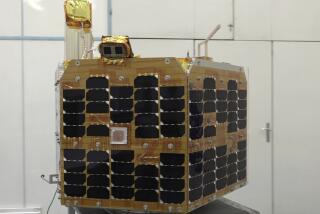Science / Medicine : High-Tech Successes Bring Talk of More Military Use of Space
- Share via
One legacy of the Persian Gulf war almost certainly will be a greater use of space for military purposes, including relatively simple systems that could blow the next Saddam Hussein out of his bunker and radar satellites that would keep track of everything that moves throughout a war zone.
The trend toward the militarization of space has been growing in recent years, partly because of the Star Wars program, but it is generally discussed in terms of passive systems such as surveillance satellites rather than active weapons-delivery systems that could strike targets on the ground. The war could lead to a greater emphasis on active systems, experts said last week in Los Angeles at a meeting of the American Institute of Aeronautics and Astronautics.
Not all the systems are of the sophisticated genre associated with Star Wars. One concept discussed privately by military planners includes the use of heavy weights that could drop out of orbit and hit with enough force to dig out a military command post buried 60 feet below the ground. The idea is getting attention because of Hussein’s use of hundreds of bunkers to carry on the war in the face of the most intense bombing in history.
According to some who are familiar with the concept, a space-based weapon need not even be explosive to be effective. An orbiting system could simply release a dead weight that would fire a small rocket to slow it so that it would drop out of orbit and plunge back to Earth. It would pick up speed as it descended and hit with such force that something the size of a washing machine would “dig out a bunker 60 feet below the ground,” one expert said.
A guidance system aboard the missile would control its descent and aim it at the target.
The proposal is so controversial that military planners do not like to discuss it because it would place offensive weapons systems in space, but many other ideas are enjoying considerable attention in the glow of high-tech successes in the Persian Gulf.
“High tech is the hero up to this point,” said Stanley G. Rosen, retired director of long-range planning for the U.S. Air Force Space Division in El Segundo and vice president for public policy of the American Institute of Aeronautics and Astronautics.
Rosen said the war has demonstrated a need for such things as radar satellites that can penetrate clouds and smoke that occasionally hide the battlefield, and that technology is available. “It’s here,” Rosen said.
A civilian system was flown aboard the space shuttle a few years ago and even penetrated the dry soils near the area where the war is now raging. Images produced by the system revealed ancient river beds hidden beneath the sand. The photos were good enough to guide scientists to the point where two rivers had converged, and artifacts from an ancient settlement were excavated.
A network of satellites with radar systems could cover the globe, Rosen said, giving military strategists a constant view of the entire war zone.
“You would be able to look at all the traffic,” he said, and possibly detect mobile Scud missile launchers while Iraqi troops were preparing them for launch instead of waiting until the missiles are on their way. Currently, there is no continuous radar surveillance of the war zone.
Other changes in the use of space will probably include a greater use of smaller communications satellites that could be dedicated to specific purposes, making it easier for field commanders to keep track of their troops after the ground war begins. Satellites could be programmed, for example, to track ground beacons and relay that information to commanders so that all troops are constantly monitored, Rosen said.
“Knowing where our forces are is going to be very important after the ground war begins,” he added.






